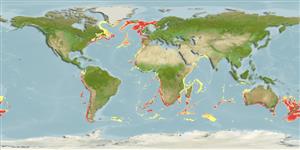Inhabits deep, cold waters over steep continental slopes, ocean ridges and sea-mounts. Shallow range of usual occurrence from Ref. 27121. Appears to be dispersed over both rough bottoms and steep, rough grounds where it feeds on crustaceans and fish. In New Zealand, the main prey include mesopelagic and benthopelagic prawns, fish, and squid, with other organisms such as mysids, amphipods and euphausiids occasionally being important (Ref. 9072). Juveniles feed mainly on crustaceans (Ref. 27075, 27076). Grows very slowly and is one of the longest lived fish species known. Based on parasite and trace-element analyses, orange roughy is a sedentary species with little movement between fish-management zones (Ref. 27089). Little is known of the larvae and juveniles which are probably confined to deep water (Ref. 27088). The fishery targets sporadically formed dense spawning and non-spawning aggregations. Marketed fresh and frozen; eaten steamed, fried, microwaved and baked (Ref. 9988). Because of severe overfishing the species has been listed as threatened by the Australian Government in 2006.
深地棲息於, 在陡峭的大陸斜坡,海洋脊與海底山脈上的寒冷水域。 平常發生的水淺範圍從參考文獻 27121. 似乎散佈了兩者的之上粗糙的底部與陡峭的, 粗燥的底部在那裡它吃甲殼類動物和魚類。 在紐西蘭,主要的獵物包括中層帶與大洋底棲性魚種蝦,魚與烏賊, 與其它的生物在一起例如糠蝦,片腳類動物與磷蝦偶然地是重要的.(參考文獻 9072) 稚魚主要捕食甲殼動物。 (參考文獻 27075,27076) 非常慢慢地生長而且是一那生命最長的被知道的魚種。 以寄生蟲與痕跡為依據-要素分析, 橘色的 roughy 是有小的在魚-管理的區域之間的運動的一個定棲的種.(參考文獻 27089) 少為人知仔魚與稚魚可能那是侷限於深水域.(參考文獻 27088) 漁場目標偶而形成了密集的產卵與非被產卵的群集。 在市場上銷售生鮮和冷凍; 清蒸, 油炸, 微波了而且燒烤了.(參考文獻 9988)
Preferred temperature (Ref.
115969): 3.5 - 8.4, mean 6.6 (based on 754 cells).
Phylogenetic diversity index (Ref.
82804): PD
50 = 0.5000 [Uniqueness, from 0.5 = low to 2.0 = high].
Bayesian length-weight: a=0.02239 (0.01607 - 0.03118), b=3.08 (2.98 - 3.18), in cm Total Length, based on LWR estimates for this species (Ref.
93245).
營養階層 (Ref.
69278): 4.3 ±0.1 se; based on diet studies.
回復力 (Ref.
120179): 非常低的, 最小族群倍增時間超過14 年 (K=0.04-0.06; tm=5-33; tmax=140; Fec=10,000).
Prior r = 0.06, 95% CL = 0.04 - 0.10, Based on 3 stock assessments.
Fishing Vulnerability (Ref.
59153): High to very high vulnerability (72 of 100).
Climate Vulnerability (Ref.
125649): Moderate to high vulnerability (54 of 100).
